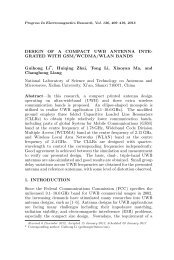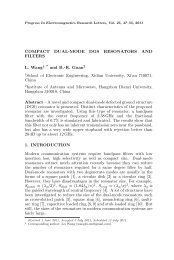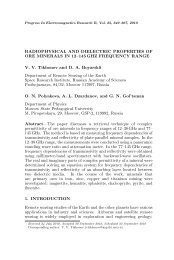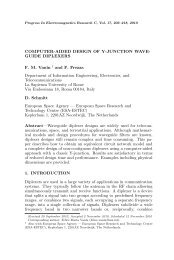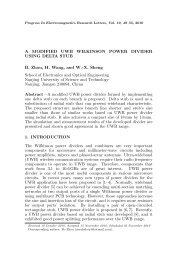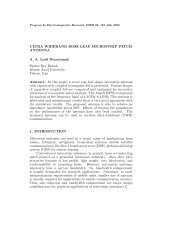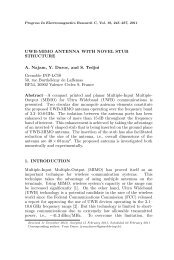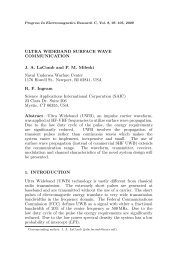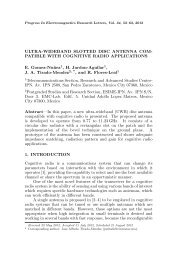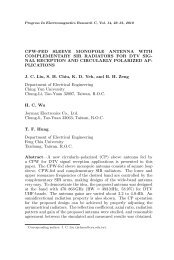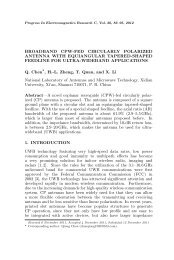PDF File (979 KB) - PIER
PDF File (979 KB) - PIER
PDF File (979 KB) - PIER
Create successful ePaper yourself
Turn your PDF publications into a flip-book with our unique Google optimized e-Paper software.
118 Angermann and Yatsyk<br />
nonlinear spectral problems should take into account the complex<br />
Fourier amplitudes of the oscillations at the frequencies nκ for numbers<br />
n > 3. Furthermore we observe, on the one hand, situations in<br />
which the influence of a weak field a inc<br />
2κ ≠ 0 on the scattering and<br />
generation process of oscillations leads to small errors in the energy<br />
balance Equation (16) not exceeding 2% (that is |W (Error) | < 0.02),<br />
and, on the other hand, situations in which the error can reach 6%<br />
(that is |W (Error) | < 0.06 there, where in the region of generation of<br />
oscillations the condition (15) is violated). The scattering, generating,<br />
energetic, and dielectric properties of the nonlinear layer are illustrated<br />
by surfaces in dependence on the parameters of the particular problem.<br />
The bottom chart depicts the surface of the value of the residual<br />
W (Error) of the energy balance Equation (see (17)) and its projection<br />
onto the top horizontal plane of the figure. In particular, by the help<br />
of these graphs it is easy to localise that region of parameters of the<br />
problem, where the error of the energy balance does not exceed a given<br />
value, that is |W (Error) | < const.<br />
The spectral characteristics of the linearised nonlinear problems<br />
with the induced dielectric permittivity at the frequencies nκ, n =<br />
1, 2, 3, of excitation and generation were calculated by means of the<br />
algorithm (14). In the graphical illustration of the eigen-fields U κn<br />
we have set a κn := 1 for κ n ∈ Ω nκ ⊂ H nκ , n = 1, 2, 3. Finally we<br />
mention that the later-used classification of scattered, generated or<br />
eigen-fields of the dielectric layer by the H m,l,p -type is identical to that<br />
given in [15, 16, 22]. In the case of E-polarisation, H m,l,p (or T E m,l,p )<br />
denotes the type of polarisation of the wave field under investigation.<br />
The subscripts indicate the number of local maxima of |E 1 | (or |U|, as<br />
|E 1 | = |U|) along the coordinate axes x, y and z (see Figure 1). Since<br />
the considered waves are homogeneous along the x-axis and quasihomogeneous<br />
along the y-axis, we study actually fields of the type<br />
H 0,0,p (or T E 0,0,p ), where the subscript p is equal to the number of<br />
local maxima of the function |U| of the argument z ∈ [−2πδ, 2πδ].<br />
In what follows we will consider a single-layered structure<br />
with a dielectric permittivity ε nκ (z, α(z), U(κ; z), U(2κ; z), U(3κ; z)) =<br />
ε (L) (z) + ε (NL)<br />
nκ , n = 1, 2, 3, where ε (L) (z) := 16 and α(z) := ∓0.01 for<br />
z ∈ [−2πδ, 2πδ], δ := 0.5, κ inc := κ := 0.375, and ϕ κ ∈ [0 ◦ , 90 ◦ ). In the<br />
subsequent figures we will use the following conventions to illustrate<br />
the different cases of incident fields:<br />
a inc<br />
2κ = 1 3 ainc κ<br />
a inc<br />
2κ = 2 3 ainc κ<br />
a inc<br />
2κ = ainc 3κ<br />
, a inc<br />
3κ = 0 . . . graphs labeled by “1/3”,<br />
, a inc = 0 . . . graphs labeled by “2/3”,<br />
3κ<br />
= 0 . . . graphs labeled by “0”.




